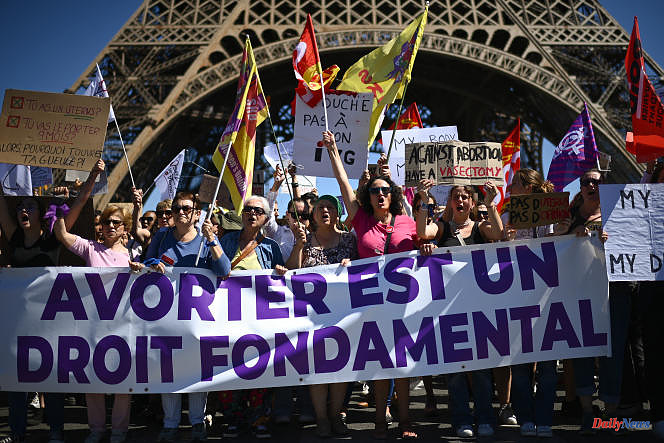The Senate, whose majority is on the right, voted on Wednesday February 1 in favor of the inclusion in the Constitution of the "freedom of women" to resort to voluntary termination of pregnancy (IVG). The wording abandons the notion of "law" that had been adopted in the National Assembly, but allows the parliamentary shuttle to continue.
The protection of abortion had been proposed by several French political groups, in reaction to the decision of the Supreme Court of the United States to annul the judgment Roe vs Wade, which guaranteed at the federal level access to abortion .
In France, the authorization of abortion acquired since the Veil law of January 17, 1975, has not been called into question. In 2020, the question was the subject of a parliamentary report which resulted in the law of March 2, 2022 aimed at strengthening this right, with, in particular, the extension of the period to the fourteenth week of pregnancy.
However, access to abortion remains fragile, deplore the professionals, who recall that in practice the use of abortion is unequal depending on the profile, place of residence or social level of women, as shown in the latest report by the research, studies, evaluation and statistics department (DREES), published on September 27, 2022.
In 2021, 223,300 abortions were performed in France, i.e. a stable volume since the beginning of the 2000s. Relative to the number of women aged 15 to 49, this figure corresponds to an abortion rate of 15.46 ‰ in 2021, marking a very slight upward trend (14.8‰ in 2010, 13.3‰ in 2000, 14‰ in 1990).
Abortions remain the most frequent among young women, with a recourse rate of 24.8‰ for 20-24 year olds and 27.2‰ for 25-29 year olds. As already observed in 2020, use rates continue to decrease for these two age groups, while they increase slightly for those aged 30 or over.
Abortions can be performed in hospitals, health or family planning and education centers, or in offices in town (GPs, gynecologists, midwives):
Abortions performed in town were performed by a total of 1,932 contracted practitioners (including 832 gynecologists, 662 general practitioners and 420 midwives). "Compared to the number of practitioners installed in the practice, this represents 2.9% of general practitioners and gynecologists and 3.5% of midwives", calculated the authors of the 2020 parliamentary report, Marie-Noëlle Battistel and Cécile Muschotti, who sound the alarm:
"The main explanation for the difficulties of access to abortion is essentially the result of lack of interest in a medical act that is undervalued and considered to be of little value. The burden of effectively maintaining this right rests essentially on a handful of activist practitioners, many of whom will soon be retired. »
In 2016, a decree extended the practice of medical abortions to midwives. The law of 2022 authorizes them to perform instrumental abortions, but "the decrees for the application of this law concerning [this] possibility have still not appeared", worried Nathalie Trignol-Viguier, the co-president of the National Association of abortion and contraception centers in Le Monde.
"As for abortion outside health establishments, i.e. medical abortion in the city or by aspiration in health centers, there is an increase in supply, and the arrival liberal midwives is spectacular", however tempers Sophie Gaudu, co-founder of the Network between the city and the hospital for orthogeny (Revho), which lists the structures that perform abortions and offers training on abortion to health personnel. "Even if I find that, over the last ten years, with the exemption from co-payments, the extension of delays, there have been many improvements in access to abortion, but a lack of recognition remains , in particular to attract young practitioners. »
Another problem is that the choice of the way to abort is not always guaranteed. The evolution of abortion methods shows a continuous progression of the medical technique, lighter in terms of care (the patient takes two drugs orally a few days apart to expel the embryo).
But Nathalie Trignol-Viguier points out that, in practice, some centers use the drug method systematically, without offering women the possibility of the instrumental method:
“These practices are established for good or bad reasons. Either because there are not enough professionals who can achieve aspirations and, therefore, rather than proposing nothing, we use degraded strategies [drug methods], or because there is a real non- willingness to practice aspiration. »
Access to abortion suffers from the current context of unequal access to care in France. Thus, the 2020 parliamentary report points to "infrastructure [which] does not meet the needs in certain departments, which generates territorial inequalities which are difficult to accept". The result is longer consultation times and longer journeys for women. Not to mention the practitioners who refuse to perform abortions under the specific conscience clause. In France, the time that elapses between the first request for an abortion and its completion is on average 7.4 days. However, this period "can vary from three to eleven days on average depending on the region", underline the authors of the parliamentary report.
Added to this are the closures of several structures in recent years. The Family Planning estimates that, for fifteen years, 130 abortion centers have closed their doors. Le Monde, for its part, counted the closure of 45 hospitals practicing abortion between 2007 and 2017. Orthogenic centers being mainly backed by public hospital maternity units, the dynamics of hospital restructuring and specialization of maternity units (between 1996 and 2019, the number of maternity wards in France fell from 814 to 461, according to the DREES) mechanically caused a drop in abortion centers in public hospitals.
How does this affect the region? According to the 2020 parliamentary report, territorial disparities remain and "women from rural areas are the first to be affected by this lack of practitioners". In urban areas, women "are not spared either due to the general insufficiency of reception capacities and the variable policies carried out by the establishments", specifies the report.
In terms of the distribution of the practice throughout the territory, the DREES also points to "regional disparities" which "remain" with the use of abortion which varies from simple to more than double in metropolitan France. The minimum is observed in Mayenne (9.2‰) and the highest rates are in the South-East (23.1‰ in Var) and in Ile-de-France (22.1‰ in Seine-Saint -Denis). Abortion rates are highest overseas, led by Guyana (44.6‰), Guadeloupe (41.2‰) and Martinique (27.7‰).
Finally, the DREES emphasizes in its analysis that women with the lowest incomes more often resort to abortion. A cross-reference with the tax data of women who had an abortion in 2016 highlights “a clear correlation between standard of living and abortion; the most precarious women resort to it significantly more than the wealthiest. » The 10% of women with the highest standard of living have a rate of abortion 11 points per 1,000 lower than that of the 10% of women with the lowest standard of living.












